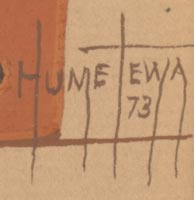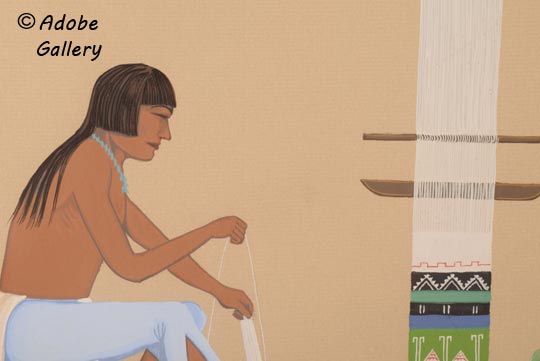James Humetewa’s Painting of a Hopi Weaving a Sash
+ Add to my watchlist Forward to Friend
Forward to Friend
- Category: Paintings
- Origin: Hopi Pueblo, Hopituh Shi-nu-mu
- Medium: gouache
- Size:
9” x 9” image;
18” x 17” framed - Item # C4838
- Price: $1750
 In this painting, Humetewa is illustrating the process of weaving a traditional Hopi sash. The male weaver is seated and is preparing the white cotton thread in preparation for weaving the white portion of the sash. The brocaded portion of the weaving on the loom is complete. The weaving on the loom is one of a pair of like weavings needed to complete the sash for use by a dancer. Unlike the female Diné of the Navajo Nation, men are typically the weavers at the pueblos. The painting is signed Humetewa and dated 73 in lower right.
In this painting, Humetewa is illustrating the process of weaving a traditional Hopi sash. The male weaver is seated and is preparing the white cotton thread in preparation for weaving the white portion of the sash. The brocaded portion of the weaving on the loom is complete. The weaving on the loom is one of a pair of like weavings needed to complete the sash for use by a dancer. Unlike the female Diné of the Navajo Nation, men are typically the weavers at the pueblos. The painting is signed Humetewa and dated 73 in lower right.
"A brocade sash is woven by the men who take part in public ceremonies. Each sash is made up of two ‘panels of plain weaving of cotton or wool, decorated at the end with designs in colored yarns and terminating with a fringe.' Two-thirds of each panel is plain-woven; then the heddles of the loom are adjusted to work the pattern in yarn. At the point where this decoration begins, a finer weft is used so that the addition of the colored yarns does not widen the cloth. The designs are virtually alike, being made up of bands of black, green, and blue with a red diamond design in the center. At their plain ends the two panels are sewn together with a roving of cord. This produces a long sash which can be wrapped about the waist and knotted on the right side with the ends hanging to the calf of the leg. The origin of the sash appears to be unknown, but the form was fully developed in the earliest modern examples collected by James Stevenson in 1879." [Roediger, 1991.132]
The sash is woven from cotton yarn. "Formerly the cotton grew wild, a small boll with a tawny fiber. Later it was cultivated. The cotton seed was planted in holes about one and a half inches deep and covered with white sand. The garden patches were divided into sections about a foot and a half square by little dirt borders to make watering easier. The bolls were picked, broken open, and the fiber sorted, cleaned, and straightened by hand. This cotton was a distinct species with plants presenting ripened bolls within eighty-four days from the time the seeds were planted. ibid, 52
James R. Humetewa, Jr. (1926-1976) Shelling Corn was a Hopi painter. He was born near Tuba City, Arizona, and later lived and worked in Santa Fe and Bernalillo. He both worked for and exhibited at the Museum of New Mexico and placed his works in many other prominent collections. He is reported to have been one of the most prolific young Hopi painters during the 1950s. He exhibited widely and is included in most of the major texts regarding early Native painting.
Condition: very good condition, framed with archival materials.
Provenance: this James Humetewa's Painting of a Hopi Weaving a Sash is from an Albuquerque client of the gallery
Reference: Roediger, Virginia More. Ceremonial Costumes of the Pueblo Indians: Their Evolution, Fabrication, and Significance in the Prayer Drama. Solo Exhibition: Museum of New Mexico, 1949
TAGS: Hopi Pueblo, Native American Paintings, James R. Humatewa Jr.

- Category: Paintings
- Origin: Hopi Pueblo, Hopituh Shi-nu-mu
- Medium: gouache
- Size:
9” x 9” image;
18” x 17” framed - Item # C4838
- Price: $1750
Adobe Gallery Recommended Reading
Adobe Gallery Recommended Items
If you are interested in this item, we would also like to recommend these other related items:



